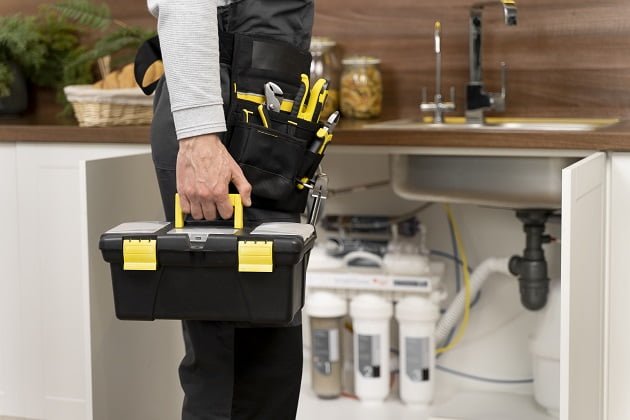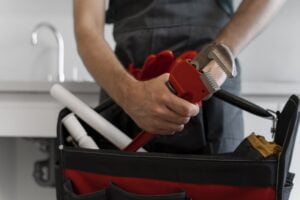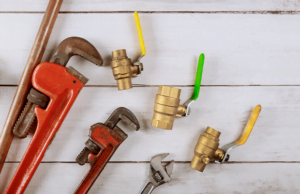Plumbing
Clean water and effective drainage systems are provided by plumbing, which is a basic need for modern living. These systems keep our houses and towns clean and comfortable. The earliest indoor plumbing systems were developed in ancient civilizations, beginning a long and interesting history of plumbing. The first plumbing systems were created in the past by the Indus
Valley civilization (c. 2600 BCE) and the Egyptians (c. 2500 BCE), who used clay and copper pipes to control water supply and cleanliness. With their huge networks of water systems and highly developed sewage systems, which featured the advance inventions like lead pipes and Rome’s Cloaca Maxima, the Greeks and Romans took this technology even further.
Sanitation methods dropped after the fall of the Roman Empire because a large portion of this advanced plumbing expertise was lost throughout the Middle Ages.
Plumbing didn’t advance until the Renaissance when there was an increase of interest in science and technology. Significant changes occurred during the Industrial Revolution as a result of the rapid population growth that demanded the creation of more effective sewage and water delivery systems. Public hygiene was transformed by inventions like the flush toilet and municipal water systems, and modern sewage systems were created by Sir Joseph Bazalgette’s work on London’s sewer system in the mid-1800s.
The first boiler was introduced to the UK in the 19th and 20th centuries, and indoor baths were widely installed. These developments marked the beginning of modern plumbing as we know it today. The invention of the first boiler, named the “Geyser,” in 1868 completely changed the hot water and heating systems in homes. Additional advancements, such as electric boilers and more effective heating options, were introduced in the 20th century. With modern plumbing solutions focusing on efficiency, lowering water and energy usage, and using smart technology to manage resources more effectively, the focus has turned toward the economy and protecting the environment.
Plumbing Systems in Ancient Civilizations and Early Times
The beginnings of plumbing may be found in ancient cultures such as the Indus Valley, when clay pipes were built for private drainage systems and public baths. The development of early plumbing was important for preserving health and preventing the spread of illness. Plumbing systems were further improved by the ancient Greeks and Romans, who used lead pipes and water lines to distribute water throughout their towns. Roman scientific works like waterways and baths showed their advanced knowledge of sanitation and water management.
The Civilization of the Indus Valley
The Indus Valley culture had outstanding technical abilities about 2600 BCE when they created complex urban drainage systems. Advanced knowledge of public health and hygiene was demonstrated by the complicated systems of brick-lined sewers and private baths found in cities like Mohenjo-Daro and Harappa.
Ancient Greece and Rome
There were important plumbing inventions made by the Greeks and Romans. Aqueducts and public baths were concepts brought by the Greeks. But the huge system of aqueducts that the Romans built to supply water to towns, public baths, private homes, and fountains was what changed plumbing. The Roman baths at Bath, England, are still evidence of the Romans’ mastery of engineering.
The Medieval Era and the Sanitation Decline
During the Middle Ages, public sanitation significantly declined as a result of the loss of most of the advanced plumbing expertise that followed the fall of the Roman Empire. Sanitary standards declined during this period when most people used wells, streams, and basic techniques for disposing of waste. Once effectively managing trash and water supply, municipal facilities either fell into deterioration or were abandoned completely. Urban regions that had previously benefited from Roman sewage systems and aqueducts encountered increasing difficulties as a result of population growth and inadequate sanitation structures, which had a negative impact on public health.
However, castles and monasteries started to establish their own independent water sources, frequently consuming from adjacent springs or rivers. While the engineering of these establishments was at the height of the Middle Ages, their plumbing systems were still somewhat outdated. “Garderobes,” or ancient toilets, were created for the rich and powerful who lived in castles.
Garderobes were projecting chambers or vertical shafts that let waste fall into a pit or moat below. Although this helped to keep some distance between humans and garbage, it wasn’t very successful at managing waste on a big scale or preventing water supplies from becoming contaminated.
Being centers of scholarship and relative riches, monasteries occasionally had plumbing systems that were more sophisticated than those of the general public. They frequently maintained their own aqueducts and simple sewer systems, showing an effort to keep their living environments clean.
The majority of people in medieval times nevertheless disposed of their waste in unhygienic ways, including open pits, ditches, and cesspools, despite these attempts. Medieval communities suffered by recurrent outbreaks of watery illnesses like dysentery and cholera due to the widespread lack of proper hygiene. The extreme contrast between the dangerous living circumstances experienced by the general population and the elite’s restricted access to sanitary facilities highlighted the enormous difficulties in preserving public health in this day and age.
The Renaissance and Early Modern Period
The Renaissance had a significant impact on plumbing because it renewed interest in science and technology.In the 16th and 17th centuries the increase in population and the desire to limit people’s sickness lead to the implementation of closed sewer systems in London. Greatest improvements in cleanliness were initiated by inventions that include the flushing toilet which was invented in 1596 by Sir John Harington. Although it was not immediately used on a large scale, the design put forth by Harington paved way for additional developments.These enhancements demonstrated the Renaissance’s dedication to using scientific discoveries for useful use.further advancements.
The introduction of pipes
Lead pipes were first employed to transmit water during the Tudor era, especially in wealthy houses and public structures. Although these pipelines made water distribution more dependable, their usage was restricted to sewage because of their high cost. The majority of people still relied on natural water sources including wells. Lead pipes were invented thus helping to evolve modern plumbing systems even though they only had little usage. Moreover, the number of public baths and fountains, which meant hygiene during that period, was more frequent. The foundation for further developments was established by these small advances.
The Industrial and Sanitation Revolution
Plumbing history saw an important change during the Industrial Revolution. Urbanization, and more particularly, increased population densities in cities required, the construction of efficient sewerage and water supply networks. Two innovations which were considered revolutionarily in civilization were the establishment of elaborate subterranean sewage systems and the invention of the flush toilet by Alexander Cumming towards the year 1775.
London Sewer System and Sir Joseph Bazalgette
In the mid-19th century London experienced poor water supply and sanitation, which resulted into serious health implications. Designing a new and rather innovative sewage system for the city was entrusted to a civil engineer and he was Sir Joseph Bazalgette. He brought about the construction of very extensive sewerage systems which improved health in the community and have been used as a model in the current sewage systems globally.
The Great Stink of 1858.
The year 1858 marked a historical moment in London where the Thames River flooded with an uncomfortable stench resulting from lots of sewage in its water system. The primary delay was due to the slow development of the necessary means of performing the intended function, in response to this problem, which required building a new sewage system of Bazalgette that led the waste flow to the cleaning facilities downstream.
The Boilers’ Introduction
Considerable progress in heating systems was made alongside the creation of modern plumbing. Benjamin Waddy Maughan created the first boiler, known as the “Geyser,” in 1868. This unique device was a coal-fired water heating system that heated water in a copper tank using a gas flame. The earlier techniques for heating water, which relied on open flames and were significantly less effective, were greatly improved by the Geyser. Because of Maughan’s
invention, indoor plumbing is now easier and more comfortable overall and has a more regular and stable hot water supply.
Baxi and the First Gas Boiler
Richard Baxendale established Baxi, the first gas boiler firm in the UK, in the same year, 1868. Compared to the previous coal-fired technologies, this innovative idea made heating systems more dependable and efficient. Natural gas was the fuel source used by the gas boiler, which produced a heating solution that was cleaner and easier to regulate. The invention of Baxi was a critical turning point in the development of heating technology and opened the door for the modern heating systems we use today. Gas boilers changed home heating by increasing its efficiency, safety, and accessibility for a larger population.
Twentieth-century and Modern Plumbing
Plumbing made major advances in the 20th century with the widespread installation of bathrooms in homes, developments in boiler systems, and the development of plastic pipe. During this period, strict standards were also established to guarantee the effectiveness and safety of plumbing systems throughout the nation.
Boiler Technology Advances
With the introduction of combi boilers, system boilers, and conventional boilers, boiler technology advanced even further. Boiler types range in their benefits and ability to meet different household requirements. Combi boilers gained popularity mainly because of their small size and high energy efficiency.
Boilers Introduction
Modern plumbing development featured improvements in heating systems as well. Benjamin Waddy Maughan in 1868, created the first boiler which he named the “Geyser.” This coal-fired water heating device greatly improved heating over open flames by using a gas flame to heat water in a copper tank.
Combi Boilers
Because they can combine a water heater and a central heating boiler into one small device, combi boilers, also known as combo boilers, are quite common in modern houses. They don’t require a separate water tank or cylinder because of their multipurpose purpose, which enables them to supply hot water and heating on demand. They are perfect for tiny houses or flats with limited room because of their small size. Furthermore, because they only heat water when necessary, combi boilers are well-known for their energy efficiency, which lowers total energy consumption and utility costs. Larger homes can find it difficult for them to keep up with the increased demand for hot water.
Boilers System
System boilers, sometimes known as sealed system boilers, work in the same way to combi boilers but with the additional benefit of an integrated hot water cylinder. Because of their design, system boilers may at the same time give hot water to several taps and showers, which makes them ideal for bigger households with higher hot water needs. Even when numerous taps are being used at the same time, a more regular hot water flow is made possible by the independent hot water cylinder. System boilers are more small and easier to install than conventional boilers as many of their parts are integrated into the boiler itself. However, because they include an extra cylinder, they do take up more room than combi boilers.
Conventional Boilers
Cold water tanks and separate hot water cylinders are the components of conventional boilers, sometimes called normal boilers. These systems are still a popular option for older houses with existing conventional heating systems, despite being bigger and less energy-efficient than combi or system boilers. High hot water needs can be satisfied by conventional boilers, which can also serve several outlets at once without significantly decreasing water pressure. Because of the separate tanks and cylinders, they take up more room, but bigger houses using standard plumbing layouts may rely on them because of their strong design. However, when compared to more modern boiler types, their total energy efficiency is inferior.
Biomass boilers
Due to biomass boilers being adapted to heat water with the help of organic matter such as pellets of wood, chips or logs more than the gas or oil boilers, they can also be classified as being more environmentally friendly. Thus, for those individuals who are consciously concerned with the environment then the biomass boilers fall under the renewable energy sources, making them environmentally friendly. Biomass boilers are also priced higher in comparison to other types of boilers and can be greater in size as well yet in the long run, they are very financially beneficial due to low carbon emissions as well as less heating costs. Governments even give incentives as well as subsidies into the development of biomass systems.
Heating Units
Heating systems based on heat pumps allow us to heat buildings and water efficiently and with minimal harm to the environment. While heat pumps are quite expensive to install, their high efficiency can also mean the expense of heating will increase. Human beings may use them for both heating and cooling purposes and are most efficient when used in well-insulated homes. Depending on where the heat is collected, heat pumps can be divided into two categories: air-to-water heat pumps (ASHPs) and ground-to-water heat pumps (GSHPs); every type has its own installation requirements and efficiency parameters.
Electrical Boilers
Portable and lightweight, the electric boilers are suitable for homes that are unable to utilize gas boilers. Comparing to fossil fuel boilers, they are more environmental friendly as they require simple installation, have few parts that needs maintenance, and during their operation they emit no pollution. Space-constrained or smaller residences are the usual settings for electric boilers. But due to their high power demands, they might be expensive to run, and they are generally less efficient than many other boiler types. Nonetheless, electric boilers are still a good option for homeowners in search of a heating system that requires little attention or, for that matter, those who have no access to gas.
The Future of Plumbing
Learning from plumbing is useful in the sense that it provides insight as to how one should approach the task of inventing the future. Sophisticated technologies such as intelligent water management technology and greywater recycling systems are among the trends that are still advancing the field of plumbers today. Expert plumbing services will continue to play a critical part in the setup and upkeep of these complex structures.
Environmental considerations.
The plumbing industry is moving toward alternative techniques as a result of the increased focus on environmental protection. The move towards saving resources and lowering carbon footprints is reflected in inventions like rainwater collection systems and solar water heating.
Technological Progress
Plumbing is being transformed by smart home technology, which offers features like automatic water management, leak detection, and remote monitoring. These developments contribute to increased reliability and effectiveness in addition to convenience.
Conclusions
The extensive history of plumbing is proof of human creativity and the constant search for better living conditions. From the earliest drainage systems of earlier cultures to the most modern plumbing technologies available today, the evolution of plumbing reveals many significant tales of inventiveness and progress.
As we face new challenges, the long history of plumbing will affect our future advancements, ensuring that clean water and efficient sanitation will always be necessary for modern society. Plumbing improvements will be important in solving global issues like water shortages and environmental sustainability as technology develops further. Plumbing, then, is a reflection of both our previous successes and our continued dedication to raising the standard of living for the next generations.






Add comment